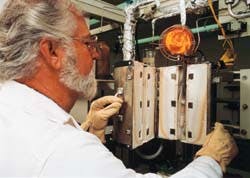OGJ SPECIAL WORLDWIDE CATALYST REPORT
A Phillips Petroleum Co. technician performs microactivity tests on an additive used to passivate metals on fluid cracking catalyst. In this apparatus, an automated syringe injects a measured dose of a selected feedstock into the catalyst. An on-line analyzer measures hydrogen offgas to determine the effects of the passivant.Catalyst manufacturers are continually improving existing catalysts and introducing new ones (photo). Refiners attempt to take advantage of these changes by constantly evaluating the performance of the catalysts they are using and assessing the potential benefits of switching to new catalysts.
The fluid catalytic cracking unit is a common target for catalyst change because the potential for improved profits is so great, and because the catalyst can be changed while the unit is on-stream. This year's Catalyst Report details specialized programs for selecting FCC, hydroprocessing, and reforming catalysts. Also outlined is a three-step procedure for optimizing FCC slide-valve differential pressure.
Two of the three steps comprise calculation procedures that enable the refiner to improve, respectively, standpipe aeration rates and the reactor/regenerator pressure balance. The third step is to optimize the physical properties of the FCC catalyst, with the help of the vendor.
Copyright 1996 Oil & Gas Journal. All Rights Reserved.
